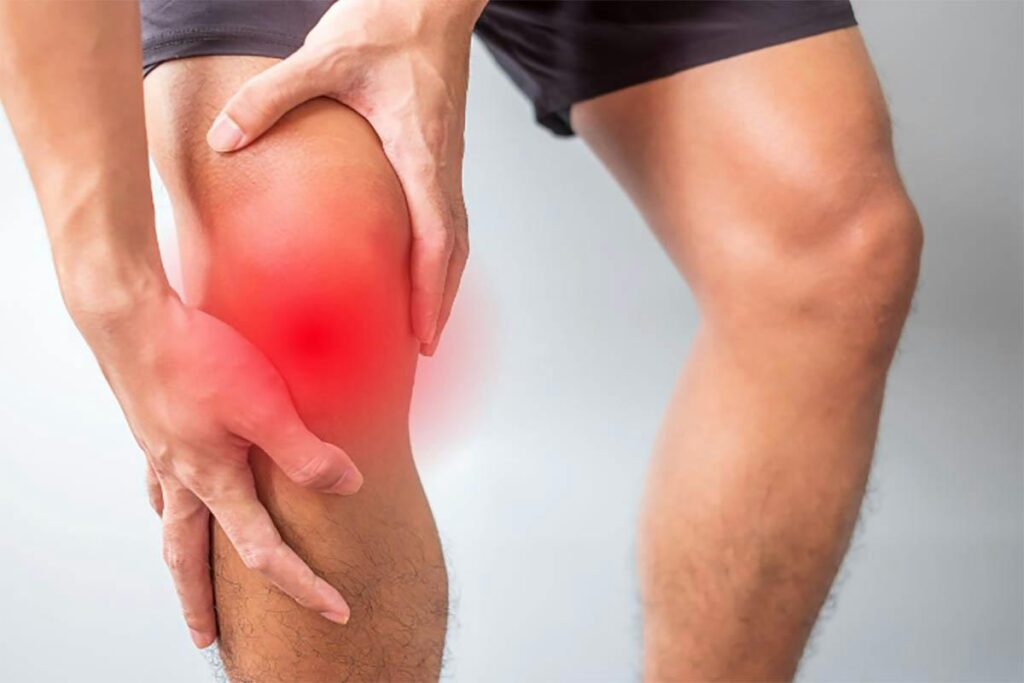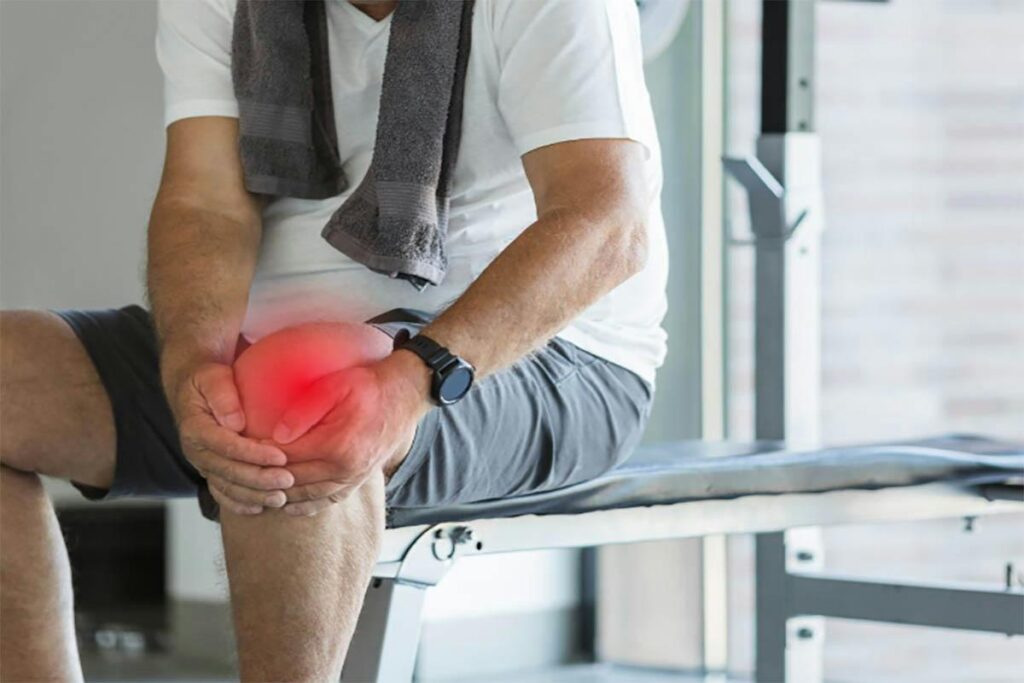Introduction
Weightlifting is an excellent method to build strength and improve overall fitness. However, like any physical activity, it comes with its risks. Weightlifter injuries are common and can hinder progress, potentially leading to long-term issues.
In this blog, we’ll explore the most common weightlifter injuries, their causes, the associated risks, and how to reduce the likelihood of getting injured.
For additional insights on movement fitness and performance, you can explore resources provided by Backcountry Physio.
Most Common Weightlifter Injuries
Weightlifters are prone to various injuries, and understanding these common lifting weights injuries is crucial for the prevention and effective management of the risk of injury. A study found that the most common weightlifting injuries (64.8%) occurred in the back (especially the lower back), knees, and shoulders. Let’s discuss each type of injury in detail.
Back Strain

Back strain, a prevalent injury among weightlifters, significantly contributes to notable injury rates, particularly lumbar spine injuries. Ranging from mild discomfort to severe pain, back strain may also be accompanied by muscle spasms.
Affected muscles: Muscles of the lower back
Causes: Occurs due to improper form or lifting too much weight, putting excessive stress on the lower back muscles.
Prevention: Pay attention to maintaining a neutral spine during lifts, avoid overloading, and ensure a gradual increase in weights to allow your lower back muscles to adapt
Shoulder Impingement

Shoulder impingement is another common issue among weightlifters. Shoulder impingement often leads to pain and restricted range of motion. In severe cases, it may progress to bursitis or rotator cuff tears.
Affected Area: Shoulder joint and rotator cuff muscles.
Causes: Results from the compression of the rotator cuff tendons and the subacromial bursa in the shoulder.
Prevention: Ensure proper shoulder mobility, strengthen the rotator cuff muscles, and prioritize exercises that promote good posture.
Rotator Cuff Tear

A more severe shoulder injury that weightlifters may encounter is a rotator cuff injury, characterized by significant pain, weakness, and difficulty with overhead movements.
Affected Area: Rotator cuff tendons in the shoulder.
Causes: Tendons are damaged, often due to repetitive overhead lifting. Chronic tears may result from ongoing stress, while acute tears can occur suddenly, especially with heavy lifting.
Prevention: Incorporate shoulder-strengthening exercises, avoid excessive overhead lifting, and pay attention to any signs of shoulder discomfort.
Bicep Strain
Bicep strain is common among weightlifters. Often manifests as a sharp pain in the front of the arm, weakness, and swelling.
Affected Muscles: Biceps muscle.
Causes: Lifting heavy weights with improper form or overusing the biceps. They may occur during exercises like curls or chin-ups, especially when the weight is too heavy or the form is compromised.
Prevention: Focus on proper lifting technique, include bicep-specific exercises in your routine, and avoid overloading the muscle.
Patellar Tendonitis

Patellar tendonitis is characterized by pain just below the kneecap. It can progress from mild discomfort to persistent pain if not addressed.
Affected Area: Patellar tendon.
Causes: Inflammation due to frequent squatting and improper knee alignment, especially during activities that load the tendon, such as squats or jumps.
Prevention: Maintain proper squatting form, strengthen the quadriceps and hamstrings, and consider using knee-supportive gear if necessary.
Knee Injuries

Knee injuries can vary from minor ligament strains to more severe tears, such as an anterior cruciate ligament (ACL) tear. Symptoms include pain, swelling, and instability, and recovery time will depend on the severity of the injury.
Affected Area: Knee joint and surrounding ligaments.
Causes: Improper squatting techniques or overloading the knees.
Prevention: Ensure proper squatting form, work on balanced muscle development around the knee joint, and avoid sudden increases in squatting intensity. Proper warm-up and cool-down routines are important for maintaining knee health.
These injuries can be caused by?
Research shows that 90% of reported fractures and dislocations were linked to free weights. Additionally, 31% of injuries resulted from technical errors, while 81% were attributed to fatigue or overloading in weightlifting. Let’s discuss the causes in detail.
Overuse
- Repeating the same movements excessively without adequate rest can lead to overuse lifting weights injury.
- This occurs when the body doesn’t have sufficient time to recover, leading to overuse injuries and stressing the muscles and joints beyond their capacity.
Lifting Too Much Weight
- Pushing the limits with excessive weights increases the risk of injuries.
- Straining to lift weights beyond your current capacity can lead to muscle tears, joint stress, and, in severe cases, more significant injuries like disc herniation.
Using Improper Form
- Incorrect lifting techniques put a strain on specific muscles and joints, making them more susceptible to injuries. Ensuring proper form is essential for injury prevention.
Not Warming Up Properly
- A thorough warm-up is crucial to prepare the muscles and joints for intense physical activity. Skipping this step increases the risk of injuries.
Poor Nutrition and Hydration
- Inadequate nutrition and hydration can contribute to muscle fatigue and decreased joint flexibility, making the body more vulnerable to injuries.
What are the risks of weightlifting injuries?
Weightlifting injuries can have both short-term and long-term consequences:
Immediate Effects
Pain: Injuries during weight lifting can cause immediate pain, ranging from mild discomfort to severe pain, depending on the nature and severity of the injury.
Swelling: Swelling is a typical response to tissue damage. It can contribute to the pain and may indicate inflammation in the affected area.
Restricted Movement: Injured muscles or joints may result in a limited range of motion, impacting the ability to perform specific exercises or activities.
Long-Term Risks
Chronic Pain: Unaddressed or inadequately managed injuries may result in persistent pain, impacting an individual’s overall quality of life and their athletic performance over the long term
Reduced Range of Motion: Persistent injuries may result in a gradual loss of flexibility and range of motion in the affected joints or muscles.
Potential for Surgery: In severe cases, especially when ligaments or tendons are involved, surgery may be necessary for repair. The surgery itself carries inherent risks and requires a lengthy recovery period.
Muscle Imbalances: Untreated injuries can lead to muscle imbalances as the body compensates for weakened or injured areas. This imbalance increases the risk of future injuries.
Psychological Impact
Fear of Re-injury: Those with weightlifting injuries, especially involving traumatic injury, may develop a fear of re-injury, impacting confidence in specific exercises.
Emotional Stress: Dealing with chronic pain or the aftermath of a severe injury can contribute to emotional stress, affecting mental well-being.
Impact on Training Progress
Disruption of Training Routine: Injuries may disrupt regular training for elite athletes, leading to periods of inactivity or modified workouts.
Loss of Gains: Extended recovery times may result in the reduction of muscle mass and strength gains achieved through consistent weightlifting.
How to Reduce the Risk?
A recent study reveals that between 1990 and 2007, close to a million Americans sought emergency room care for weight-training injuries. To effectively reduce the risk of weightlifting injuries, consider the following detailed strategies:
Gradually Increase Weight
- Implement a structured and incremental approach to weight progression, ensuring your body can safely accommodate the added stress.
Focus on Form:
- Regularly assess and refine your lifting form, seeking guidance from fitness professionals or trainers if needed. Emphasizing proper technique ensures a safer and more effective weightlifting practice.
Include Rest Days:
- A well-balanced routine that includes both intense workout sessions and rest days promotes overall muscle health and reduces the risk of fatigue-related injuries.
Warm-Up Properly:
- Dynamic stretches and light cardiovascular exercises elevate blood flow, increase body temperature, and enhance joint flexibility.
Stay Hydrated and Well-Nourished:
- Ensure your diet includes a well-balanced mix of carbohydrates, proteins, and fats, providing the necessary nutrients for muscle repair and function.
- Stay consistently hydrated, especially during and after weightlifting sessions, to promote overall health and reduce the risk of fatigue-related injuries.
Physical Therapy Can Help With Weight Lifting Injuries?
If you’ve experienced lifting injuries, don’t hesitate to seek professional assistance for optimal recovery. Explore specialized guidance and tailored rehabilitation programs from experienced physical therapists at Backcountry Physio. Take a proactive step towards healing and preventing future issues—schedule your consultation today for personalized support on your weightlifting journey.
Conclusion
Weightlifting, while rewarding, requires a cautious and mindful approach. To promote a safer and more sustainable journey, it’s crucial to understand common injuries and their causes and adopt preventive measures. This knowledge enhances safety, ensuring a prolonged and enjoyable experience in weightlifting.
FAQs
Q1: Is it normal to experience soreness after weightlifting?
A1: Yes, muscle soreness, known as delayed onset muscle soreness (DOMS), is normal after weightlifting, particularly when initiating a new routine or increasing intensity. It typically resolves within a few days.
Q2: Should I continue weightlifting if I have an existing injury?
A2: Before returning to weightlifting with an existing injury, consult a healthcare professional for advice on modifications, exercises to avoid, and a safe progression plan. This minimizes the risk of worsening the lifting weights injury. For those seeking proactive measures on how to avoid injury when lifting, prioritize proper warm-up, focus on impeccable form, and gradually increase weights.
Q3: What happens when you lift too much weight?
A3: Lifting too much weight can result in injuries like muscle tears or strains, especially if proper form isn’t maintained. It may lead to fatigue, compromising technique, and increasing the risk of accidents. Consistently lifting weights beyond your capacity can impact long-term joint health and athletic performance. Prioritize proper technique and gradual progression to minimize these risks.



